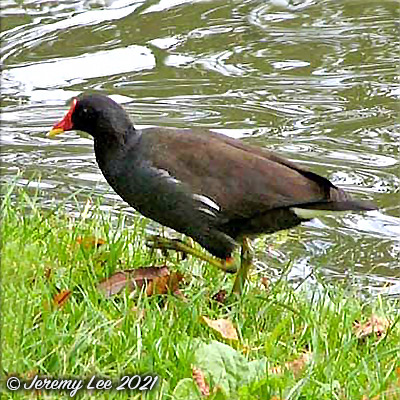
 |
|
Scientific Classifications explained » Amphibians » Ants » Aphids » Bees » Beetles » Birds » Bugs » Butterflies » Caterpillars » Damselflies » Dragonflies » Earwigs » Flies » Frog/Leafhoppers » Fungi » Galls » Grasshoppers » Harvestmen » Hoverflies » Lacewings » Ladybirds » Leaf Mines » Lichens » Mammals » Millipedes » Mosses » Moths » Sawflies » Slugs » Snails » Spiders » Trees & Shrubs » Wasps » Wild Flowers » Woodlice » Postboxes |
UK Nature > Birds > Gallinula chloropus

Scientific Name: Gallinula chloropus Common Name: Moorhen Gallinula chloropus, more commonly known as the Moorhen, measures approximately 33cm in length. Easily recognised by sooty-black body colour, red base to bill, greenish-yellow legs, white line along the side and white undertail coverts with black central line. The white side line and undertail pattern also distinguish the immature from young Coot. The tail is held high and is jerked both when swimming and walking. They have a varied diet, including leaves, seeds, berries, worms, snails and fish. Their nest is a mound of waterside vegetation, reeds, sticks etc, collected from the vicinity and usually contsructed in the middle of waterside reeds etc. Found commonly by a variety of waterside habitats throughout the UK including marshes, ponds, lakes with shore vegetation. Often seen in parks, where it will walk about on the grass. |
|

https://www.uknature.co.uk is a website dedicated to showing the immense diversity of UK nature and wildlife. Our vast range of habitats, from lowland arable to snow covered mountains, from storm-ravaged coastlines to peaceful inland freshwater lakes and rivers, from dry, sandy heaths to deciduous and coniferous forests, all these habitats contribute to the abundance of UK nature. We have wild birds in huge numbers either residing or visiting our shores (597 recorded species as at July 2013) and we must also not forget the humble back garden with its grass lawns, flower beds filled with nectar rich flowers, shrubs and trees, all designed to attract huge numbers of insects such as bees, moths, butterflies and hoverflies; and finally the small ponds which provide safe havens for frogs, toads, newts and even slow worms and grass snakes. www.uknature.co.uk is the showcase for my personal passion, photographing uknature in all its glory. I sincerely hope you all enjoy the fruits of my labours. This site and all images contained therein is © Jeremy Lee 2004 - 2025. All Rights Reserved. Site design by Jeremy Lee. Site development & IT Support by Stuart Lee. |